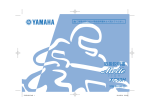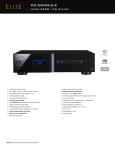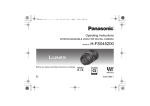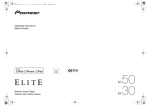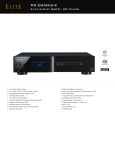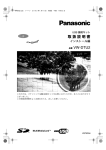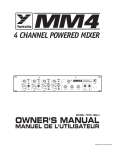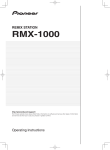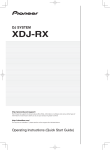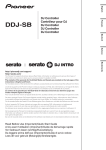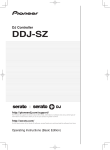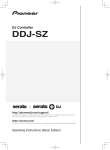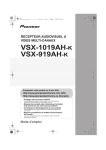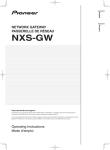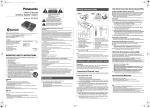Download Operating Instructions Mode d`emploi
Transcript
A20_CUXE.book 1 ページ 2012年3月2日 金曜日 午前11時32分 Operating Instructions Mode d’emploi Integrated Amplifier Amplificateur Intégré A20_CUXE.book 2 ページ 2012年3月2日 金曜日 午前11時32分 Operating Environment IMPORTANT CAUTION RISK OF ELECTRIC SHOCK DO NOT OPEN The lightning flash with arrowhead symbol, within an equilateral triangle, is intended to alert the user to the presence of uninsulated “dangerous voltage” within the product’s enclosure that may be of sufficient magnitude to constitute a risk of electric shock to persons. CAUTION: TO PREVENT THE RISK OF ELECTRIC SHOCK, DO NOT REMOVE COVER (OR BACK). NO USER-SERVICEABLE PARTS INSIDE. REFER SERVICING TO QUALIFIED SERVICE PERSONNEL. The exclamation point within an equilateral triangle is intended to alert the user to the presence of important operating and maintenance (servicing) instructions in the literature accompanying the appliance. D3-4-2-1-1_A1_En WARNING This equipment is not waterproof. To prevent a fire or shock hazard, do not place any container filled with liquid near this equipment (such as a vase or flower pot) or expose it to dripping, splashing, rain or moisture. WARNING To prevent a fire hazard, do not place any naked flame sources (such as a lighted candle) on the equipment. D3-4-2-1-7a_A1_En D3-4-2-1-3_A1_En VENTILATION CAUTION WARNING Before plugging in for the first time, read the following section carefully. The voltage of the available power supply differs according to country or region. Be sure that the power supply voltage of the area where this unit will be used meets the required voltage (e.g., 230 V or 120 V) written on the rear panel. D3-4-2-1-4*_A1_En When installing this unit, make sure to leave space around the unit for ventilation to improve heat radiation (at least 30 cm at top, 10 cm at rear, and 10 cm at each side). WARNING Slots and openings in the cabinet are provided for ventilation to ensure reliable operation of the product, and to protect it from overheating. To prevent fire hazard, the openings should never be blocked or covered with items (such as newspapers, table-cloths, curtains) or by operating the equipment on thick carpet or a bed. D3-4-2-1-7b*_A1_En Operating environment temperature and humidity: +5 °C to +35 °C (+41 °F to +95 °F); less than 85 %RH (cooling vents not blocked) Do not install this unit in a poorly ventilated area, or in locations exposed to high humidity or direct sunlight (or strong artificial light) D3-4-2-1-7c*_A1_En If the AC plug of this unit does not match the AC outlet you want to use, the plug must be removed and appropriate one fitted. Replacement and mounting of an AC plug on the power supply cord of this unit should be performed only by qualified service personnel. If connected to an AC outlet, the cut-off plug can cause severe electrical shock. Make sure it is properly disposed of after removal. The equipment should be disconnected by removing the mains plug from the wall socket when left unused for a long period of time (for example, when on vacation). D3-4-2-2-1a_A1_En CAUTION The /I STANDBY/ON switch on this unit will not completely shut off all power from the AC outlet. Since the power cord serves as the main disconnect device for the unit, you will need to unplug it from the AC outlet to shut down all power. Therefore, make sure the unit has been installed so that the power cord can be easily unplugged from the AC outlet in case of an accident. To avoid fire hazard, the power cord should also be unplugged from the AC outlet when left unused for a long period of time (for example, when on vacation). D3-4-2-2-2a*_A1_En A20_CUXE.book 3 ページ 2012年3月2日 金曜日 午前11時32分 This product is for general household purposes. Any failure due to use for other than household purposes (such as long-term use for business purposes in a restaurant or use in a car or ship) and which requires repair will be charged for even during the warranty period. K041_A1_En The Safety of Your Ears is in Your Hands Get the most out of your equipment by playing it at a safe level – a level that lets the sound come through clearly without annoying blaring or distortion and, most importantly, without affecting your sensitive hearing. Sound can be deceiving. Over time, your hearing “comfort level” adapts to higher volumes of sound, so what sounds “normal” can actually be loud and harmful to your hearing. Guard against this by setting your equipment at a safe level BEFORE your hearing adapts. POWER-CORD CAUTION Handle the power cord by the plug. Do not pull out the plug by tugging the cord and never touch the power cord when your hands are wet as this could cause a short circuit or electric shock. Do not place the unit, a piece of furniture, etc., on the power cord, or pinch the cord. Never make a knot in the cord or tie it with other cords. The power cords should be routed such that they are not likely to be stepped on. A damaged power cord can cause a fire or give you an electrical shock. Check the power cord once in a while. When you find it damaged, ask your nearest PIONEER authorized service center or your dealer for a replacement. S002*_A1_En K057_A1_En BE SURE TO OBSERVE THE FOLLOWING GUIDELINES: • Do not turn up the volume so high that you can’t hear what’s around you. • Use caution or temporarily discontinue use in potentially hazardous situations. • Do not use headphones while operating a motorized vehicle; the use of headphones may create a traffic hazard and is illegal in many areas. S001a_A1_En This Class B digital apparatus complies with Canadian ICES-003. D8-10-1-3_A1_En D3-7-13-67*_A1_En IMPORTANT NOTICE THE MODEL NUMBER AND SERIAL NUMBER OF THIS EQUIPMENT ARE ON THE REAR OR BOTTOM. RECORD THESE NUMBERS ON YOUR ENCLOSED WARRANTY CARD AND KEEP IN A SAFE PLACE FOR FUTURE REFERENCE. D36-AP9-1_A1_En This product contains mercury. Disposal of this material may be regulated due to environmental considerations. For disposal or recycling information, please contact your local authorities or the Electronics Industries Alliance : www.eiae.org. ESTABLISH A SAFE LEVEL: • Set your volume control at a low setting. • Slowly increase the sound until you can hear it comfortably and clearly, without distortion. • Once you have established a comfortable sound level, set the dial and leave it there. Caution To prevent fire hazard, the Class 1 Wiring Cable should be used for connection with speaker, and should be routed away from hazards to avoid damage to the insulation of the cable. WARNING: Handling the cord on this product or cords associated with accessories sold with the product may expose you to chemicals listed on proposition 65 known to the State of California and other governmental entities to cause cancer and birth defect or other reproductive harm. D36-P5_B1_En Information to User Alterations or modifications carried out without appropriate authorization may invalidate the user’s right to operate the equipment. D8-10-2_A1_En CAUTION This product satisfies FCC regulations when shielded cables and connectors are used to connect the unit to other equipment. To prevent electromagnetic interference with electric appliances such as radios and televisions, use shielded cables and connectors for connections. D8-10-3a_A1_En FEDERAL COMMUNICATIONS COMMISSION DECLARATION OF CONFORMITY This device complies with part 15 of the FCC Rules. Operation is subject to the following two conditions: (1) This device may not cause harmful interference, and (2) this device must accept any interference received, including interference that may cause undesired operation. Product Name: Integrated Amplifier Model Number: A-20 Responsible Party Name: PIONEER ELECTRONICS (USA) INC. SERVICE SUPPORT DIVISION Address: 1925 E. DOMINGUEZ ST. LONG BEACH, CA 90810-1003, U.S.A. Phone: 1-800-421-1404 URL: http://www.pioneerelectronics.com D8-10-4*_C1_En A20_CUXE.book 4 ページ 2012年3月2日 金曜日 午前11時32分 Thank you for buying this Pioneer product. 1) 2) 3) 4) 5) 6) 7) Read these instructions. Keep these instructions. Heed all warnings. Follow all instructions. Do not use this apparatus near water. Clean only with dry cloth. Do not block any ventilation openings. Install in accordance with the manufacturer’s instructions. 8) Do not install near any heat sources such as radiators, heat registers, stoves, or other apparatus (including amplifiers) that produce heat. 9) Do not defeat the safety purpose of the polarized or grounding-type plug. A polarized plug has two blades with one wider than the other. A grounding type plug has two blades and a third grounding prong. The wide blade or the third prong are provided for your safety. If the provided plug does not fit into your outlet, consult an electrician for replacement of the obsolete outlet. 10) Protect the power cord from being walked on or pinched particularly at plugs, convenience receptacles, and the point where they exit from the apparatus. 11) Only use attachments/accessories specified by the manufacturer. 12) Use only with the cart, stand, tripod, bracket, or table specified by the manufacturer, or sold with the apparatus. When a cart is used, use caution when moving the cart/apparatus combination to avoid injury from tip-over. Please read through these operating instructions so that you will know how to operate your model properly. After you have finished reading the instructions, put them in a safe place for future reference. Contents 01 Before you start What’s in the box . . . . . . . . . . . . . . . . . . . . . . . . . .5 Loading the batteries in the remote control . . . . . .5 Using the remote control. . . . . . . . . . . . . . . . . . . . .5 Installing the amplifier . . . . . . . . . . . . . . . . . . . . . .5 02 Connecting up 13) Unplug this apparatus during lightning storms or when unused for long periods of time. 14) Refer all servicing to qualified service personnel. Servicing is required when the apparatus has been damaged in any way, such as power-supply cord or plug is damaged, liquid has been spilled or objects have fallen into the apparatus, the apparatus has been exposed to rain or moisture, does not operate normally, or has been dropped. D3-7-13-69_En Making cable connections . . . . . . . . . . . . . . . . . . .6 About “Bi-wiring” . . . . . . . . . . . . . . . . . . . . . . . . . .6 Connecting speaker cables . . . . . . . . . . . . . . . . . .7 Connecting audio cables . . . . . . . . . . . . . . . . . . . .7 Using centralized control with other Pioneer components. . . . . . . . . . . . . . . . . . . . . . . . . . . . . .7 Plugging in . . . . . . . . . . . . . . . . . . . . . . . . . . . . . .7 03 Controls and displays Front panel. . . . . . . . . . . . . . . . . . . . . . . . . . . . . . .8 Rear panel . . . . . . . . . . . . . . . . . . . . . . . . . . . . . . .9 Remote control . . . . . . . . . . . . . . . . . . . . . . . . . .10 04 Operation Playback . . . . . . . . . . . . . . . . . . . . . . . . . . . . . . .11 Set the power to Standby. . . . . . . . . . . . . . . . . . . .11 NOTE: This equipment has been tested and found to comply with the limits for a Class B digital device, pursuant to Part 15 of the FCC Rules. These limits are designed to provide reasonable protection against harmful interference in a residential installation. This equipment generates, uses, and can radiate radio frequency energy and, if not installed and used in accordance with the instructions, may cause harmful interference to radio communications. However, there is no guarantee that interference will not occur in a particular installation. If this equipment does cause harmful interference to radio or television reception, which can be determined by turning the equipment off and on, the user is encouraged to try to correct the interference by one or more of the following measures: — Reorient or relocate the receiving antenna. — Increase the separation between the equipment and receiver. — Connect the equipment into an outlet on a circuit different from that to which the receiver is connected. — Consult the dealer or an experienced radio/TV technician for help. D8-10-1-2_A1_En 4 Making an audio recording . . . . . . . . . . . . . . . . .12 To set for automatic standby status (Auto Power Down) . . . . . . . . . . . . . . . . . . . . . . .12 Restoring all the settings to the factory default settings . . . . . . . . . . . . . . . . . . . . . . . . . . . . . . . .12 05 Additional information Troubleshooting . . . . . . . . . . . . . . . . . . . . . . . . . .13 Cleaning the unit . . . . . . . . . . . . . . . . . . . . . . . . .13 Specifications . . . . . . . . . . . . . . . . . . . . . . . . . . .14 A20_CUXE.book 5 ページ 2012年3月2日 金曜日 午前11時32分 Before you start 01 Before you start 3 Close the rear lid. Please confirm that the following accessories are in the box when you open it. • Remote control • AAA/IEC R03 dry cell batteries x2 • Operating instructions (This document) Using the remote control The remote has a range of about 7 m at an angle of about 30º from the remote sensor. Deutsch Note • Illustrations featured in the Operating Instructions may have been modified or simplified for ease of explanation, and may therefore differ from the actual product appearance. 1 Open the rear lid. The batteries included with the unit have been provided to allow you check product operation and may not last long. We recommend using alkaline batteries that have a longer life. 30 ° WARNING • Do not use or store batteries in direct sunlight or other excessively hot place, such as inside a car or near a heater. This can cause batteries to leak, overheat, explode or catch fire. It can also reduce the life or performance of batteries. Keep in mind the following when using the remote control: • Make sure that there are no obstacles between the remote and the remote sensor on the unit. • Remote operation may become unreliable if strong sunlight or fluorescent light is shining on the unit’s remote sensor. • Remote controllers for different devices can interfere with each other. Avoid using remotes for other equipment located close to this unit. • Replace the batteries when you notice a fall off in the operating range of the remote. Installing the amplifier Русский When installing this unit, make sure to put it on a level and stable surface. • Don’t install it on the following places: – on a color TV (the screen may distort) – near a cassette deck (or close to a device that gives off a magnetic field). This may interfere with the sound. – in direct sunlight – in damp or wet areas Español Incorrect use of batteries may result in such hazards as leakage and bursting. Observe the following precautions: • When inserting the batteries, make sure not to damage the springs on the battery’s terminals. • Do not use any batteries other than the ones specified. Also, do not use a new battery together with an old one. • When loading the batteries into the remote control, set them in the proper direction, as indicated by the polarity marks ( and ). • Do not heat batteries, disassemble them, or throw them into flames or water. • Batteries may have different voltages, even if they are the same size and shape. Do not use different types of batteries together. 7m Nederlands Caution 2 Insert the new batteries, matching the polarities as indicated inside the case. 30 ° Italiano Loading the batteries in the remote control – in extremely hot or cold areas – in places where there is vibration or other movement – in places that are very dusty – in places that have hot fumes or oils (such as a kitchen) • Do not mount the unit on a sofa or other object or material with absorbent qualities, since sound quality may be adversely affected. Français What’s in the box • To prevent leakage of battery fluid, remove the batteries if you do not plan to use the remote control for a long period of time (1 month or more). If the fluid should leak, wipe it carefully off the inside of the case, then insert new batteries. If a battery should leak and the fluid should get on your skin, flush it off with large quantities of water. • When disposing of used batteries, please comply with governmental regulations or environmental public institution’s rules that apply in your country/ area. English Chapter 1: 5 En A20_CUXE.book 02 6 ページ 2012年3月2日 金曜日 午前11時32分 Connecting up Chapter 2: Caution Connecting up Making cable connections Caution • Before making or changing the connections, switch off the power and disconnect the power cord from the AC outlet. • Connect the power cord after all the connections between devices have been completed. Speaker system B Left Right SACD/CD player R Network audio player R L • The SIGNAL GND terminal is provided to reduce noise when connecting the unit to components such as an analog turntable. • Do not connect the PHONO (MM) terminals to any component other than a turntable; also, do not connect to a turntable equipped with built-in equalizer. An excessively high sound output may be produced, resulting in damage to your speakers or other devices. • The unit’s PHONO (MM) terminals are designed to be used with turntables equipped with MM (moving-magnet) type cartridges. Turntables equipped with MC (moving-coil) cartridges cannot be used. • Make sure not to bend the cables over the top of this unit (as shown in the illustration). If this happens, the magnetic field produced by the transformers in this unit may cause a humming noise from the speakers. • During playback, be sure that both the SPEAKERS A button and SPEAKERS B button are set to ON (page 8). Speaker system Speaker system Left Right Remove the shorting bar between the + and – terminals. HIGH HIGH LOW LOW This unit’s rear panel L This unit’s rear panel L R L • If your turntable has a grounding wire, secure it to the ground terminal on this amplifier. R Note R L R L R L R L Power cord L R • When connecting a tape cassette deck, playback noise may be heard, depending on the installation location. This noise is caused by leakage flux from the amplifier’s transformer. In this event, change the installation location, or move the deck farther from the amplifier. • iPod is a trademark of Apple Inc., registered in the U.S. and other countries. L R AUDIO OUTPUT R L OUTPUT L L R R iPod Music> Extras> Settings> Shuffle Songs Backlight About “Bi-wiring” PLAY REC L L L R R R This unit can be used with speakers that support biwiring. Be sure to connect the high-frequency and low-frequency connections correctly. MENU Turntable 6 En Tuner iPod dock, etc CD recorder or tape deck Left Right Speaker system A Caution • When using bi-wiring to connect speakers, avoid adverse affects on the amplifier by being sure to remove the HIGH and LOW short bars provided with the speakers. For detailed information, consult the instructions provided with the speakers. • When using speakers with removable network circuits, note that if the network is removed, no effect will be produced and damage may be caused to the speaker. • Another method of connection is to connect the SPEAKERS A terminals to HIGH and the SPEAKERS B terminals to LOW (reverse that shown in the illustration). 02_connecting_up.fm 7 ページ 2012年3月9日 金曜日 午後1時37分 Connecting up 02 Connecting audio cables 1 Connect the white plug to the left (L) jack, and the red plug to the right (R) jack. Be sure to insert the plugs fully into the jacks. Twist the cable cores. 3 Left (white) Retighten the terminal nut. 1 2 3 Right (red) Multiple Pioneer components equipped with CONTROL IN/OUT jacks can be connected to the A-20 unit, allowing centralized control of the components via the remote sensor on the A-20. This also allows remote control of components not equipped with a remote sensor, or installed in places where the component’s remote sensor cannot be accessed. 10 mm Important • When going on a trip or otherwise not using the unit for an extended period, always disconnect the power cord from its outlet. Note that various internal settings will not be lost even if the power cord is disconnected from its outlet for an extended time. • If it is necessary to detach the power cord, first be sure to press the /I STANDBY/ON button on the front panel of the unit so the A-20 is turned OFF. IN CONTROL To other Pioneer component equipped with CONTROL IN jack After you’ve finished making all connections, plug the unit into an AC outlet. This unit’s rear panel To AC outlet A-20 Power cord A-20 remote control Aim remote control at the sensor on the A-20. Note Русский • For connections use a commercially available monaural miniplug cord (without resistor). • When connecting the CONTROL IN/OUT jacks, commercially available audio cords must also be used to make analog connections. Merely connecting the CONTROL IN/OUT jacks alone will not allow proper system control. • When a control cord is connected to the A-20’s CONTROL IN jack, the unit cannot be controlled by pointing the remote control at the A-20 (the remote sensor is automatically disabled). Español • When using only one set of speaker terminals (SPEAKERS A or SPEAKERS B), or when utilizing bi-wiring connections, the speaker used should have a nominal impedance between 4 Ω and 16 Ω. When using both sets of terminals, the connected speakers should have nominal impedance between 8 Ω and 32 Ω. Consult the instructions accompanying your speakers for details regarding the impedance value. • Make sure the positive and negative (+/–) terminals on the amplifier match those on the speakers. • These speaker terminals carry HAZARDOUS live voltage. To prevent the risk of electric shock when connecting or disconnecting the speaker cables, disconnect the power cord before touching any uninsulated parts. • Make sure that all the bare speaker wire is twisted together and inserted fully into the speaker terminal. If any of the bare speaker wire touches the back panel it may cause the power to cut off as a safety measure. Plug the power cord into an AC outlet. Nederlands 1 Caution Italiano Other Pioneer component equipped with CONTROL IN/ OUT jacks Deutsch OUT • If you want to use speaker cables terminated with banana plugs, screw the speaker terminal fully shut, then plug the banana plug into the end of the speaker terminal. Plugging in Français 2 Loosen the nut on the SPEAKERS terminal, and insert the speaker cable into the exposed hole in the terminal shaft. Using centralized control with other Pioneer components English Connecting speaker cables 7 En A20_CUXE.book 03 8 ページ 2012年3月2日 金曜日 午前11時32分 Controls and displays Chapter 3: 6 Controls and displays Front panel 8 1 2 4 3 7 6 1 7 8 9 /I STANDBY/ON Switches the amplifier between off and on. When power is turned on, the power indicator in the center of the button will light. 2 STANDBY/APD indicator When power is set to standby, the indicator lights red. When the Auto Power Down (APD) function is on, the indicator lights green (page 12). 3 SPEAKERS A button/indicator Use this button to listen to the speaker system connected to SPEAKERS A terminals. On : The indicator lights. Sound is heard from the speaker system. (Sound will also be produced from the PHONES jack.) Off : The indicator goes off. No sound is heard from the speaker system. Set to this position when listening with headphones. 4 SPEAKERS B button/indicator Use this button to listen to the speaker system connected to SPEAKERS B terminals. On : The indicator lights. Sound is heard from the speaker system. (Sound will also be produced from the PHONES jack.) Off : The indicator goes off. No sound is heard from the speaker system. Set to this position when listening with headphones. En DIRECT button/indicator On : The indicator lights: When this button is set to ON, sound signals are output directly, without being passed through the various adjustment circuits (BASS, TREBLE, BALANCE, LOUDNESS). This allows reproduction of the signals with greater fidelity, but it disables any settings made with the BASS, TREBLE, BALANCE or LOUDNESS controls. Off : The indicator goes off: The signal passes through the various frequency adjusting circuits. When the indicator is OFF, adjustments can be made with the BASS, TREBLE, BALANCE, and LOUDNESS controls. 5 10 PHONES jack Use to connect headphones. No sound is produced when the POWER AMP DIRECT button is ON. 9 8 Remote sensor Receives the signals from the remote control (page 5). 11 12 5 13 LOUDNESS button/indicator Use when listening at low volume levels. On : The indicator lights: Boosts low and high frequencies to give added punch to playback even at a low volume level. Off : The indicator goes off: Should normally be left in this position. • This button does not operate when the DIRECT button is in the on position. • When sound volume is raised, the amount of change produced by the LOUDNESS circuit is reduced. BASS tone control Use to adjust the low-frequency tone. The center position is the flat (normal) position. When turned to the right, low-frequency tones are emphasized; when turned to the left, low-frequency tones are de-emphasized. • This button does not operate when the DIRECT button is in the on position. 10 TREBLE tone control Use to adjust the high-frequency tone. The center position is the flat (normal) position. When turned to the right, high-frequency tones are emphasized; when turned to the left, high-frequency tones are deemphasized. • This button does not operate when the DIRECT button is in the on position. 11 BALANCE control Should normally be left in the center position. Adjust balance if the sound is louder from one of the speakers. If the right side is louder, turn toward the L (left) position and if the left side is louder, turn toward the R (right) position. • This button does not operate when the DIRECT button is in the on position. 12 VOLUME control Use to adjust the volume level. (Also allows adjustment of the headphone sound volume.) 13 INPUT SELECTOR knob/indicators Turn the knob clockwise or counterclockwise so that the indicator lights for your desired input source. Turning the knob clockwise causes the lit indicator to right. Turning counterclockwise causes it to left. When the remote control’s MUTE button is pressed to mute the sound, the indicator for the input source selected with the INPUT SELECTOR knob flashes. A20_CUXE.book 9 ページ 2012年3月2日 金曜日 午前11時32分 Controls and displays 03 English Rear panel See pages 6 to 7 for details regarding connections. 2 1 3 2 4 2 5 2 6 Français 1 10 2 9 12 2 11 GND (Turntable ground) terminal 13 10 AUX IN terminals 11 NETWORK IN terminals 2 SPEAKERS A terminals (Right channel) 12 RECORDER IN/OUT terminals 3 SPEAKERS B terminals (Right channel) 13 CONTROL IN/OUT jack 4 SPEAKERS B terminals (Left channel) Power cord 7 PHONO (MM) IN terminals 8 TUNER IN terminals 9 SACD/CD IN terminals Nederlands SPEAKERS A terminals (Left channel) 6 Italiano This ground terminal is designed to help reduce noise when a turntable is connected. It is not a safety ground. 5 Deutsch 8 2 7 Español Русский 9 En A20_CUXE.book 03 10 ページ 2012年3月2日 金曜日 午前11時32分 Controls and displays 1 Remote control 2 1 2 STANDBY/ON Switches the amplifier between standby and on. 5 6 Input selector buttons Press to select an input source. These select the component connected to the corresponding input on the rear panel. 3 NETWORK AUDIO PLAYER control buttons Use to control Pioneer network audio player. 7 4 3 8 4 9 Use to control Pioneer SACD player. (Cannot be used to perform playback/pause on the PD-D6/PD-D6MK2/PD-D9/PD-D9MK2 models.) 5 10 11 DIMMER This button allows the illumination of the unit's front panel indicators to be set in three levels (does not affect the STANDBY indicator). 6 3 SACD PLAYER control buttons LOUDNESS Use to set the loudness circuit ON/OFF (page 8). 7 DIRECT Press to access Direct listening (page 8). 8 3 4 SPEAKERS A button/indicator Use this button to listen to the speaker system connected to SPEAKERS A terminals. 9 SPEAKERS B button/indicator Use this button to listen to the speaker system connected to SPEAKERS B terminals. 10 MUTE Mutes/unmutes the sound. 11 VOLUME +/– Use to set the listening volume. 10 En A20_CUXE.book 11 ページ 2012年3月2日 金曜日 午前11時32分 Operation 04 Set the power to Standby Operation 1 Press the remote control’s STANDBY/ ON button. iPod dock, etc Turntable SACD/CD player Network audio player NETWORK AUDIO PLAYER /I STANDBY/ON FUNCTION STANDBY PURE AUDIO CD recorder or tape deck iPod Music> Extras> Settings> Shuffle Songs Backlight Tuner MENU N-50 Hi-Bit 32 iPod/USB 5V 2.1A 6 Note 6 6 5 3 4 Start playback of the component you selected in step 1. 2 5 Adjust playback volume with VOLUME control. Turn power ON to the unit. • If the unit is in the standby mode, press the remote control’s STANDBY/ON button. Select the source you want to playback. 6 Adjust the tone to your preference using the BASS and TREBLE controls, and LOUDNESS button. If the DIRECT button has been set to ON, these controls are disabled. Русский Select the playback component. • When using the front panel controls, rotate the INPUT SELECTOR knob. Español 3 Nederlands 1 Turn on the power of the playback component. Italiano Playback Playback • If the power cord is disconnected when the unit is in the standby mode the unit will turn off, but when the cord is then reconnected, the unit will not automatically turn on. After reconnecting the power cord, press the remote control’s STANDBY/ON button to turn the power on. Deutsch 2 The next time you wish to turn on the power, press the remote control’s STANDBY/ON button. • If the front panel’s STANDBY/ON button is pressed, the power will be turned off. In this case, if the power is off, pressing the remote control’s STANDBY/ON button will not turn on the power. To turn on the power again, press the front panel’s STANDBY/ON button. Français Playback English Chapter 4: 11 En A20_CUXE.book 04 12 ページ 2012年3月2日 金曜日 午前11時32分 Operation To set for automatic standby status (Auto Power Down) Making an audio recording You can make an audio recording from any audio source connected to the amplifier. iPod dock, etc Turntable SACD/CD player iPod Music> Extras> Settings> Shuffle Songs Backlight Network audio player NETWORK AUDIO PLAYER /I STANDBY/ON FUNCTION STANDBY PURE AUDIO Tuner N-50 MENU When this condition is set, if no input signal is detected for 30 minutes, the unit will automatically enter standby status. 1 If the unit’s power is ON, hold the unit’s front-panel DIRECT button and LOUDNESS button depressed simultaneously for three seconds. Hi-Bit 32 iPod/USB 5V 2.1A Playback When this condition is set to ON, the STANDBY/APD indicator on the unit’s front panel will light green. Press the buttons again to disable the setting. • The factory default setting is OFF. Note Recording Audio recording component (CD recorder, tape deck, etc.) 1 Select the source you want to record. 1 Depending on the device connected, excessive noise produced by the device may be interpreted as an audio signal, thus preventing the Automatic Power-Down function from operating. Restoring all the settings to the factory default settings 1 When power is in standby mode, hold the front-panel’s DIRECT button and SPEAKERS A button depressed simultaneously for five seconds. 2 Start recording, then start playback of the source component. 2 12 En Turn power ON to the unit. A20_CUXE.book 13 ページ 2012年3月2日 金曜日 午前11時32分 Additional information Additional information Incorrect operations are often mistaken for trouble and malfunctions. If you think that there is something wrong with this component, check the points below. Sometimes the trouble may lie in another component. Investigate the other components and electrical appliances being used. If the trouble cannot be rectified even after exercising the checks listed below, ask your nearest Pioneer authorized service center or your dealer to carry out repair work. • If the unit does not operate normally due to external effects such as static electricity disconnect the power plug from the outlet and insert again to return to normal operating conditions. Power turns off. •Is the Auto Power Down function turned ON? If you do not want the power to turn off automatically, disable the Auto Power Down function (page 12). During playback, sound stops, and the STANDBY/APD indicator flashes red at about 1 second intervals. •The unit’s internal temperature has risen and the safety circuit has operated. - Turn power OFF, and allow the unit to cool before turning the power ON again. - Install the unit in a location with better ventilation. - Confirm that the unit is installed correctly; if the unit is turned on again without being allowed to cool, the same symptoms may appear (page 5). During playback, sound stops, and the STANDBY/APD indicator flashes red at about 2 second intervals. •Are you using speakers with impedance values not supported by this unit? Confirm the speaker’s nominal impedance value (page 7). •Are any speaker cables loose from the SPEAKERS terminals and touching other wires or the surface of the rear panel? Disconnect the power cord and reconnect the speaker cables correctly (page 7). When power is turned on, the STANDBY/APD indicator flashes at irregular intervals. •The unit’s circuitry is damaged. Disconnect the power cord and consult your dealer or nearest Pioneer authorized service center. •Are the connection cables or speaker cables disconnected on one side? Reconnect securely (page 6). Can’t operate the remote control. •Replace the battery (page 5). •Operate within 7 m, 30 ºof the remote sensor on the front panel (page 5). •Remove the obstacle or operate from another position. •Avoid exposing the remote sensor on the front panel to direct light. •Is the control cord for one component connected improperly? Confirm correct connections (page 7). Русский No sound from one speaker. Español No sound is output when a function is •A connection cable is disconnected or connected improperly. Check your selected. connections (page 6). •Connectors or pin plugs on a cable are dirty. Wipe off any dirt from connectors and pin plugs. •Confirm that the unit’s input selector is set to the desired playback component. Set selector correctly (page 11). •Press MUTE on the remote control to turn muting off (page 10). Nederlands • Is the power plug disconnected from the power outlet? Connect the power plug correctly to its outlet (page 7). Italiano Remedy The power does not turn on. Deutsch Problem • Use a polishing cloth or dry cloth to wipe off dust and dirt. • When the surface is dirty, wipe with a soft cloth dipped in some neutral cleanser diluted five or six times with water, and wrung out well, and then wipe again with a dry cloth. Do not use furniture wax or cleansers. • Never use thinners, benzine, insecticide sprays or other chemicals on or near this unit, since these will corrode the surface. Français Troubleshooting Cleaning the unit English Chapter 5: 05 13 En A20_CUXE.book 05 14 ページ 2012年3月2日 金曜日 午前11時32分 Additional information Specifications Amplifier section Power output specification is for when power supply is 120 V. • Continuous power output (both channels driven at 20 Hz to 20 kHz) THD 0.1 %, 4 Ω . . . . . . . . . . . . . . . . . . . . . . .50 W + 50 W THD 0.05 %, 8 Ω . . . . . . . . . . . . . . . . . . . . . . .30 W+30 W Audio section • Input (Sensitivity/Impedance) SACD/CD, NETWORK, TUNER, AUX, RECORDER . . . . . . . . . . . . . . . . . . . . . . . . . . . . . . . . . . . 200 mV/50 kΩ PHONO (MM) . . . . . . . . . . . . . . . . . . . . . . . 2.8 mV/50 kΩ • Output (Level/Impedance) RECORDER OUT . . . . . . . . . . . . . . . . . . . . 200 mV/2.2 kΩ PHONES . . . . . . . . . . . . . . . . . . . . . . . . . . . . 250 mV/32 Ω • Frequency response Miscellaneous Power requirements . . . . . . . . . . . . . . . . . . . . . . . . . . . . . . . . . AC 120 V, 60 Hz Power consumption . . . . . . . . . . . . . . . . . . . . . . . . 135 W In standby . . . . . . . . . . . . . . . . . . . . . . . . . . . . . . . . . 0.3 W Dimensions . . . . . . . . . . . . .435 mm (W) x 128 mm (H) x 360 mm (D) Weight (without package) . . . . . . . . . . . . . . . . . . . . 7.2 kg Accessories Remote control . . . . . . . . . . . . . . . . . . . . . . . . . . . . . . . . . 1 AAA/IEC R03 dry cell batteries . . . . . . . . . . . . . . . . . . . . 2 Operating instructions (This document) Note • Specifications and the design are subject to possible modifications without notice, due to improvements. • Corporation and product names mentioned herein are trademarks or registered trademarks of the respective corporations. SACD/CD, NETWORK, TUNER, AUX, RECORDER . . . . . . . . . . . . . . . . . . . . . . . . . . . 5 Hz to 100 kHz dB* PHONO (MM) . . . . . . . . . . . . . 20 Hz to 20 kHz ±0.5 dB* * Measured with DIRECT button switched on. • Tone control (When VOLUME is set to -30 dB) Bass . . . . . . . . . . . . . . . . . . . . . . . . . . . . ± 10 dB (100 Hz) Treble . . . . . . . . . . . . . . . . . . . . . . . . . . . ± 10 dB (10 kHz) • Signal-to-Noise Ratio (IHF SHORTED, A-NETWORK) SACD/CD, NETWORK, TUNER, AUX, RECORDER . . . . . . . . . . . . . . . . . . . . . . . . . . . . . . . . . . . . . . . . 105 dB* PHONO (MM, 2.8 mV input) . . . . . . . . . . . . . . . . . 77 dB* * Measured with DIRECT button switched on. • Speaker load impedance A, B. . . . . . . . . . . . . . . . . . . . . . . . . . . . . . . . . . 4 Ω to 16 Ω A+B . . . . . . . . . . . . . . . . . . . . . . . . . . . . . . . . . 8 Ω to 32 Ω Bi-wiring. . . . . . . . . . . . . . . . . . . . . . . . . . . . . . 4 Ω to 16 Ω © 2012 PIONEER CORPORATION. All rights reserved. 14 En A20_CUXE.book 15 ページ 2012年3月2日 金曜日 午前11時32分 Additional information 05 English Français Deutsch Italiano Nederlands Español Русский 15 En A20_CUXE-Frca.book Page 2 Monday, March 5, 2012 2:22 PM Milieu de fonctionnement IMPORTANT ATTENTION DANGER D´ELECTROCUTION NE PAS OUVRIR Ce symbole de l’éclair, placé dans un triangle équilatéral, a pour but d’attirer l’attention de l’utilisateur sur la présence, à l’intérieur du coffret de l’appareil, de “tensions dangereuses” non isolées d’une grandeur suffisante pour représenter un risque d’électrocution pour les êtres humains. ATTENTION : POUR ÉVITER TOUT RISQUE D’ÉLECTROCUTION, NE PAS ENLEVER LE COUVERCLE (NI LE PANNEAU ARRIÈRE). AUCUNE PIÈCE RÉPARABLE PAR L’UTILISATEUR NE SE TROUVE À L’INTÉRIEUR. CONFIER TOUT ENTRETIEN À UN PERSONNEL QUALIFIÉ UNIQUEMENT. Ce point d’exclamation, placé dans un triangle équilatéral, a pour but d’attirer l’attention de l’utilisateur sur la présence, dans les documents qui accompagnent l’appareil, d’explications importantes du point de vue de l’exploitation ou de l’entretien. D3-4-2-1-1_A1_Fr AVERTISSEMENT Cet appareil n’est pas étanche. Pour éviter les risques d’incendie et de décharge électrique, ne placez près de lui un récipient rempli d’eau, tel qu’un vase ou un pot de fleurs, et ne l’exposez pas à des gouttes d’eau, des éclaboussures, de la pluie ou de l’humidité. AVERTISSEMENT Pour éviter les risques d’incendie, ne placez aucune flamme nue (telle qu’une bougie allumée) sur l’appareil. D3-4-2-1-7a_A1_Fr D3-4-2-1-3_A1_Fr PRÉCAUTION DE VENTILATION AVERTISSEMENT Avant de brancher l’appareil pour la première, lisez attentivement la section suivante. La tension de l’alimentation électrique disponible varie selon le pays ou la région. Assurez-vous que la tension du secteur de la région où l’appareil sera utilisé correspond à la tension requise (par ex. 230 V ou 120 V), indiquée sur le panneau arrière. D3-4-2-1-4*_A1_Fr Lors de l’installation de l’appareil, veillez à laisser un espace suffisant autour de ses parois de manière à améliorer la dissipation de chaleur (au moins 30 cm sur le dessus, 10 cm à l’arrière et 10 cm de chaque côté). AVERTISSEMENT Les fentes et ouvertures du coffret sont prévues pour la ventilation, pour assurer un fonctionnement stable de l’appareil et pour éviter sa surchauffe. Pour éviter les risques d’incendie, ne bouchez jamais les ouvertures et ne les recouvrez pas d’objets, tels que journaux, nappes ou rideaux, et n’utilisez pas l’appareil posé sur un tapis épais ou un lit. D3-4-2-1-7b*_A1_Fr Température et humidité du milieu de fonctionnement : De +5 °C à +35 °C (de +41 °F à +95 °F) ; Humidité relative inférieure à 85 % (orifices de ventilation non obstrués) N’installez pas l’appareil dans un endroit mal ventilé ou un lieu soumis à une forte humidité ou en plein soleil (ou à une forte lumière artificielle). D3-4-2-1-7c*_A1_Fr Si la fiche d’alimentation secteur de cet appareil ne convient pas à la prise secteur à utiliser, la fiche doit être remplacée par une appropriée. Ce remplacement et la fixation d’une fiche secteur sur le cordon d’alimentation de cet appareil doivent être effectués par un personnel de service qualifié. En cas de branchement sur une prise secteur, la fiche de coupure peut provoquer une sérieuse décharge électrique. Assurez-vous qu’elle est éliminée correctement après sa dépose. L’appareil doit être déconnecté en débranchant sa fiche secteur au niveau de la prise murale si vous prévoyez une période prolongée de non utilisation (par exemple avant un départ en vacances). D3-4-2-2-1a_A1_Fr ATTENTION L’interrupteur /I STANDBY/ON de cet appareil ne coupe pas complètement celui-ci de sa prise secteur. Comme le cordon d’alimentation fait office de dispositif de déconnexion du secteur, il devra être débranché au niveau de la prise secteur pour que l’appareil soit complètement hors tension. Par conséquent, veillez à installer l’appareil de telle manière que son cordon d’alimentation puisse être facilement débranché de la prise secteur en cas d’accident. Pour éviter tout risque d’incendie, le cordon d’alimentation sera débranché au niveau de la prise secteur si vous prévoyez une période prolongée de non utilisation (par exemple avant un départ en vacances). D3-4-2-2-2a*_A1_Fr A20_CUXE-Frca.book Page 3 Monday, March 5, 2012 2:22 PM Ce produit est destiné à une utilisation domestique générale. Toute panne due à une utilisation autre qu'à des fins privées (comme une utilisation à des fins commerciales dans un restaurant, dans un autocar ou sur un bateau) et qui nécessite une réparation sera aux frais du client, même pendant la période de garantie. K041_A1_Fr La protection de votre ouïe est entre vos mains Pour assurer le rendement optimal de votre matériel et – plus important encore – la protection de votre ouïe, réglez le volume à un niveau raisonnable. Pour ne pas altérer votre sens de la perception, le son doit être clair mais ne produire aucun vacarme et être exempt de toute distorsion. Votre ouïe peut vous jouer des tours. Avec le temps, votre système auditif peut en effet s’adapter à des volumes supérieurs, et ce qui vous semble un « niveau de confort normal » pourrait au contraire être excessif et contribuer à endommager votre ouïe de façon permanente. Le réglage de votre matériel à un volume sécuritaire AVANT que votre ouïe s’adapte vous permettra de mieux vous protéger. CHOISISSEZ UN VOLUME SÉCURITAIRE: • Réglez d’abord le volume à un niveau inférieur. • Montez progressivement le volume jusqu’à un niveau d’écoute confortable ; le son doit être clair et exempt de distorsions. • Une fois que le son est à un niveau confortable, ne touchez plus au bouton du volume. N’OUBLIEZ PAS DE RESPECTER LES DIRECTIVES SUIVANTES: • Lorsque vous montez le volume, assurez-vous de pouvoir quand même entendre ce qui se passe autour de vous. • Faites très attention ou cessez temporairement l’utilisation dans les situations pouvant s’avérer dangereuses. • N’utilisez pas des écouteurs ou un casque d’écoute lorsque vous opérez un véhicule motorisé ; une telle utilisation peut créer des dangers sur la route et est illégale à de nombreux endroits. NOTE IMPORTANTE SUR LE CABLE D’ALIMENTATION Merci d’avoir acheté ce produit Pioneer. Tenir le câble d’alimentation par la fiche. Ne pas débrancher la prise en tirant sur le câble et ne pas toucher le câble avec les mains mouillées. Cela risque de provoquer un court-circuit ou un choc électrique. Ne pas poser l’appareil ou un meuble sur le câble. Ne pas pincer le câble. Ne pas faire de noeud avec le câble ou l’attacher à d’autres câbles. Les câbles d’alimentation doivent être posés de façon à ne pas être écrasés. Un câble abîmé peut provoquer un risque d’incendie ou un choc électrique. Vérifier le câble d’alimentation de temps en temps. Contacter le service après-vente PIONEER le plus proche ou le revendeur pour un remplacement. Veuillez lire entièrement ce mode d’emploi afin de pouvoir faire fonctionner correctement le modèle que vous avez choisi. Après avoir fini la lecture du mode d’emploi, placez-le dans un endroit sûr afin de pouvoir vous y référer plus tard. S002*_A1_Fr Table des matières 01 Préparatifs Contenu de la boîte . . . . . . . . . . . . . . . . . . . . . . . . 4 Chargement des piles de la télécommande . . . . . . 4 Utilisation de la télécommande . . . . . . . . . . . . . . . .4 Installation de l’amplificateur . . . . . . . . . . . . . . . . 4 02 Raccordement Raccordements des câbles . . . . . . . . . . . . . . . . . . 5 A propos de “bi-câblage (bi-wiring)”. . . . . . . . . . . . 5 Connexion des câbles d’enceinte. . . . . . . . . . . . . . 6 Raccordement des câbles audio . . . . . . . . . . . . . . 6 Commande centralisée avec d’autres composants Pionner . . . . . . . . . . . . . . . . . . . . . . . 6 Branchement. . . . . . . . . . . . . . . . . . . . . . . . . . . . . 6 03 Commandes et afficheur Panneau avant. . . . . . . . . . . . . . . . . . . . . . . . . . . . 7 Panneau arrière. . . . . . . . . . . . . . . . . . . . . . . . . . . 8 Télécommande . . . . . . . . . . . . . . . . . . . . . . . . . . . 9 04 Fonctionnement Lecture . . . . . . . . . . . . . . . . . . . . . . . . . . . . . . . . 10 Réglage de la puissance sur la mise en veille . . . .10 Réalisation d’un enregistrement audio . . . . . . . . 11 Pour régler un statut de veille automatique (fonction de mise hors tension automatique). . . . 11 Pour restaurer tous les réglages sur les valeurs par défaut . . . . . . . . . . . . . . . . . . . . . . . . 11 05 Informations supplémentaires Guide de dépannage . . . . . . . . . . . . . . . . . . . . . . 12 Nettoyage de l’unité. . . . . . . . . . . . . . . . . . . . . . . 12 Spécifications . . . . . . . . . . . . . . . . . . . . . . . . . . . 13 S001a_A1_Fr 3 A20_CUXE-Frca.book 01 Page 4 Monday, March 5, 2012 2:22 PM Préparatifs Chapitre 1 : Préparatifs Contenu de la boîte 3 Fermez le couvercle arrière. Veuillez confirmer que les accessoires suivants sont présents dans la boîte quand vous l’ouvrez. • Télécommande • Piles sèches AAA/IEC R03 x2 • Mode d’emploi (ce document) Utilisation de la télécommande La télécommande a une portée d’environ 7 m avec un angle de 30° par rapport au capteur de télécommande. Remarque • Les illustrations des instructions opérationnelles peuvent avoir été modifiées ou simplifiées dans le but de clarification et en conséquence peuvent différer de l’apparence actuelle du produit. Chargement des piles de la télécommande 1 Ouvrez le couvercle arrière. Les piles incluses avec l’unité ont été fournies pour permettre de contrôler le fonctionnement du produit et ne dureront pas longtemps. Nous recommandons d’utiliser des piles alcalines qui ont une durée de vie utile plus longue. AVERTISSEMENT • N’utilisez ni ne conservez les piles sous la lumière directe du soleil ou dans un endroit excessivement chaud, comme une voiture ou à proximité d’un appareil de chauffage. Les piles risqueraient de fuir, de surchauffer, d’exploser ou de s’enflammer. Leur durée de vie ou leur performance pourrait également être réduite. Attention 2 Placez les piles neuves, en faisant correspondre la polarité à celle du boîtier. 4 Frca • Pour éviter que les piles ne fuient, enlever les piles lorsque le produit n’est pas censé être utilisé pendant une période prolongée (à savoir 1 mois ou plus). Si les piles ont fuit, nettoyer soigneusement l’intérieur du compartiment et placer ensuite les piles. Si une pile fuit et que du liquide entre en contact avec votre peau, nettoyer à grande quantité d’eau. • Lorsque vous jetez des piles usées, veuillez vous conformer aux normes gouvernementales ou à la réglementation des institutions publiques environnementales en vigueur dans votre pays ou région. Toute utilisation incorrecte des piles peut entraîner des accidents, par exemple une fuite ou une explosion. Respectez les précautions suivantes : • Lorsque vous placez les piles, prenez soin de ne pas endommager les ressorts des bornes des piles . • Ne pas utiliser de piles autres que celles qui sont indiquées. Ne pas utiliser non plus une pile neuve avec une pile usée. • Lorsque vous installez les piles dans la télécommande, orientez-les batteries dans la bonne direction en respectant la polarité ( et ). • Ne pas chauffer, ni démonter, ni ne jeter les piles dans le feu ou l’eau. • La tension des piles peut différer l’une de l’autre et cela même si leur type et forme sont identiques. Utiliser ensemble uniquement des piles du même type. 30 ° 30 ° 7m Gardez à l’esprit ce qui suit lorsque vous utilisez la télécommande : • Assurez-vous de l’absence d’obstacles entre la télécommande et le capteur de l’appareil. • La télécommande risque de ne pas fonctionner correctement si la lumière du soleil ou une lampe fluorescente puissante éclaire le capteur de l’appareil. • Les télécommandes de différents appareils peuvent interférer entre elles. Evitez d’utiliser des télécommandes commandant d’autres équipements situés à proximité de cet appareil. • Remplacez les piles lorsque vous constatez une diminution de la portée de fonctionnement de la télécommande. Installation de l’amplificateur Lors de l’installation de l’appareil, assurez-vous que ce dernier est posé sur une surface plane et stable. • N’installez pas l’appareil dans les endroits suivants : – sur un téléviseur couleur (les images à l’écran pourraient être déformées) – à proximité d’une platine à cassettes (ou d’un appareil qui produit un champ magnétique). Le son pourrait s’en trouver affecté. – à la lumière directe du soleil – à l’humidité – à des températures extrêmes – en présence de vibrations ou autres mouvements – à la poussière – à la fumée ou aux émanations graisseuses (cuisine par ex.) • Ne pas installer l’unité sur un divan ou tout autre objet/matériau ayant des caractéristiques absorbantes sous risque d’affecter la qualité du son. 02_connecting_up.fm Page 5 Monday, March 5, 2012 5:52 PM Raccordement 02 Attention Raccordement Attention • Avant d’effectuer ou de modifier les raccordements, mettez l’appareil hors tension et débranchez le cordon d’alimentation de la prise secteur. • Connectez le cordon d’alimentation après avoir effectué toutes les connexions entre les appareils. R L LOW Système des Gauch HIGH LOW Panneau arrière Italiano R Lecteur audio réseau HIGH Enlevez la tige de court-circuit entre les bornes + et –. L Panneau arrière R L R Remarque L R L R L R L Cordon d’alimentation L R A propos de “bi-câblage (bi-wiring)” L R AUDIO OUTPUT R L OUTPUT L R R iPod Music> Extras> Settings> Shuffle Songs Backlight L L L R R R Cette unité peut être utilisée avec des enceintes prenant en charge le bi-câblage. Toujours raccorder correctement la haute fréquence et la basse fréquence. MENU Platine Syntoniseur Station d’accueil iPod, etc. Enregistreur CD ou à bande Droite Gauch Système d’enceinte A Русский L PLAY REC Attention • Lorsque vous utilisez un bi-câblage pour connecter les enceintes, assurez-vous d’enlever les tiges de court-circuit HIGH et LOW fournies avec les haut-parleurs pour ne pas créer d’effets adverses sur l’amplificateur. Pour de plus amples informations, consultez les instructions fournies avec les enceintes. • Lorsque vous utilisez des enceintes avec des circuits de réseau amovibles, si le réseau est enlevé, aucun effet ne se produira et les enceintes peuvent subir des dommages. • Vous pouvez alternativement connecter les bornes SPEAKERS A sur HIGH et celles sur LOW SPEAKERS B (à l’inverse de ce qui est illustré). Español R • Lors de la connexion d’un enregistreur à bande, le bruit de fond peut être perçu, selon l’emplacement de l’installation. Ce bruit provient d’une fuite du transformateur de l’amplificateur. Dans ce cas, changez l’emplacement de l’installation ou distancez davantage la platine de l’amplificateur. • iPod est une marque commerciale d’Apple Inc., enregistrées aux États-Unis et dans d’autres pays. Nederlands • Si votre platine dispose d’un fil de mise à la terre, fixez-le à la borne de terre de cet amplificateur. L Deutsch Système d’enceinte B Droite Gauch Lecteur SACD/CD Système des Droite Français Raccordements des câbles • La borne SIGNAL GND est fournie pour réduire le bruit lors de la connexion de l’unité aux composants, tels que la platine. • Ne pas connecter les bornes PHONO (MM) à un autre composant qu’une platine; ne pas connecter non plus une platine dotée d’un égalisateur intégré. Un son émis trop fort peut se produire, ce qui endommagerait les enceintes ou les autres appareils. • Les bornes de l’unité PHONO (MM) ont été conçues pour être utilisées avec des des platines dotées de cartouches de type MM (à aimant mobile). Ne pas utiliser les les platines dotées de cartouches MC (à bobine mobile). • Assurez-vous de ne pas plier les câbles par dessus cette unité (comme indiqué dans l’illustration). Si cela se produit, le champ magnétique produit par les transformateurs dans cette unité peut provoquer un ronflement des enceintes. • Au cours de la lecture, assurez-vous que les boutons SPEAKERS A et SPEAKERS B sont sur Marche (ON) (page 7). English Chapitre 2 : 5 Frca A20_CUXE-Frca.book 02 Page 6 Friday, March 9, 2012 2:16 PM Raccordement Connexion des câbles d’enceinte 1 Entortillez l’âme des câbles. 2 Desserrez l’écrou sur la borne SPEAKERS et introduisez le câble de l’enceinte dans le trou exposé dans la borne. 3 Resserrez l’écrou de la borne. 1 2 3 10 mm • Pour utiliser des câbles de haut-parleur dotés de fiches bananes, vissez la borne du haut-parleur complètement fer mée puis branchez la fiche banane dans l’extrémité de la borne du haut-parleur. • Assurez-vous que tous les fils dénudés d’enceinte sont entortillés ensemble et totalement introduits dans la borne de l’enceinte. Si l’un des fils dénudés entre en contact avec le panneau arrière, l’alimentation sera automatiquement coupée par mesure de sécurité. Raccordement des câbles audio Connectez la fiche blanche à la prise gauche (L) et la fiche rouge à la prise droite (R). Assurez-vous de bien brancher les fiches dans les prises. Commande centralisée avec d’autres composants Pionner De nombreux composants Pionneer dotés de prises CONTROL IN/OUT peuvent être connectés aux unités A-20 centralisant la commande des composants via le télécapteur sur l’A-20. Cette centralisation permet d’utiliser une télécommande dont les composants ne sont pas munis d’un télécapteur ou sont installés à des emplacements inaccessibles par le télécapteur. IN Gauche (blanche) OUT Vers d’autres composants Pioneer munis d’une prise CONTROL IN CONTROL Droite (rouge) Vers d’autres composants Pioneer munis de prises CONTROL IN/OUT Frca Après avoir effectué toutes les connexions, branchez l’unité dans une prise CA. Panneau arrière Cordon d’alimentation Attention 6 Important • Lorsque vous devez vous absenter ou quelle que soit la situation où l’unité ne sera pas utilisée pendant une longue durée, toujours déconnecter le cordon d’alimentation de ses prises. Les réglages internes sont toujours conservés et cela même si le cordon d’alimentation est déconnecté de sa prise pendant une longue période. • Si le cordon d’alimentation doit être déconnecté, assurez-vous d’appuyer sur le bouton /I STANDBY/ON sur le panneau avant de l’unité de manière à ce que l’A-20 soit sur Arrêt (OFF) . Vers la prise CA A-20 • Lorsque vous utilisez uniquement un jeu de bornes de l’enceinte (SPEAKERS A ou SPEAKERS B), ou lorsque vous utilisez des connexions bi-câblage, l’enceinte utilisée doit disposer d’une impédance nominale entre 4 Ω et 16 Ω. Lorsque vous utilisez des jeux de bornes, les enceintes connectées doivent disposer d’une impédance nominale entre 8 Ω et 32 Ω. Pour de plus amples informations sur la valeur de l’impédance, consultez les instructions jointes aux enceintes. • Vérifiez que les bornes positive et négative (+/–) sur l’amplificateur correspondent à celles des enceintes. • Les bornes des haut-parleurs sont sous une tension ACTIVE DANGEREUSE. Pour éviter tout risque de décharge électrique lors du branchement et du débranchement des câbles d’enceinte, débranchez le cordon d’alimentation avant de toucher des parties non isolées. Branchement Télécommande A-20 Visez la télécommande en direction du capteur sur l’A-20. Remarque • Pour établir la connexion, utilisez un cordon minifiche mono en vente dans le commerce (sans résistance). • Lors de la connexion des prises CONTROL IN/OUT, des cordons audio en vente dans le commerce doivent être utilisés pour établir les connexions analogiques. La connexion des prises CONTROL IN/OUT ne suffit pas à à assurer un contrôle adéquat du système. • Lorsqu’un cordon de commande est connecté à la prise de l’A-20 CONTROL IN, il est impossible de contrôler l’unité en pointant la télécommande à l’A-20 (le télécapteur est automatiquement désactivé). 1 Branchez le cordon d’alimentation dans une prise CA. A20_CUXE-Frca.book Page 7 Monday, March 5, 2012 2:22 PM Commandes et afficheur 03 8 9 10 Indicateur STANDBY/APD Lorsque l’alimentation est en mode veille, l’indicateur s’allume en rouge. Lorsque la fonction de mise hors tension automatique (APD) est activée, l’indicateur s’allume en vert (page 11). 3 Bouton/indicateur SPEAKERS A 12 4 13 9 Commande de la tonalité BASS Bouton/indicateur SPEAKERS B Ce bouton permet d’écouter le système d’enceinte connecté aux bornes SPEAKERS B. On : L’indicateur s’allume. Le son est entendu du système d’enceinte. (Le son sera également émis de la prise PHONES). Off : L’indicateur s’éteint. Aucun son n’est entendu du système d’enceinte. Réglez à cette position lorsque vous utilisez des écouteurs. 5 Bouton/indicateur LOUDNESS Utilisez lorsque vous utilisez à des niveaux faibles. On : L’indicateur s’allume : Augmente les fréquences hautes et basses pour donner du punch aux lectures même à niveau sonore faible. Off : L’indicateur s’éteint: Doit en principe rester dans cette position. • Ce bouton ne fonctionne pas lorsque le bouton DIRECT est en position de marche. • Lorsque vous augmentez le son, la quantité de changement produit par le circuit LOUDNESS est réduite. Utilisez pour régler la tonalité basse fréquence. La position centrale correspond à une position plate (normale). Lorsque vous tournez sur la droite, les tonalités basse fréquence sont accentuées; lorsque vous tournez sur la gauche, les tonalités basse fréquence sont atténuées. • Ce bouton ne fonctionne pas lorsque le bouton DIRECT est en position de marche. 10 Commande de la tonalité TREBLE Utilisez pour régler la tonalité haute fréquence. La position centrale correspond à une position plate (normale). Lorsque vous tournez sur la droite, les tonalités haute fréquence sont accentuées; lorsque vous tournez sur la gauche, les tonalités haute fréquence sont atténuées. • Ce bouton ne fonctionne pas lorsque le bouton DIRECT est en position de marche. 11 Commande BALANCE Doit en principe rester au centre. Réglez l’équilibre si le son est plus fort d’une enceinte que de l’autre. Si le côté droit est plus fort, tournez vers la gauche (L) et si le côté gauche est plus fort, tournez vers la droite (R). • Ce bouton ne fonctionne pas lorsque le bouton DIRECT est en position de marche. Utilisez pour régler le niveau du volume. (Permet également d’effectuer des réglages du volume sonore des écouteurs.) Русский 12 Commandes du VOLUME Español Ce bouton permet d’écouter le système d’enceinte connecté aux bornes SPEAKERS A. On : L’indicateur s’allume. Le son est entendu du système d’enceinte. (Le son sera également émis de la prise PHONES). Off : L’indicateur s’éteint. Aucun son n’est entendu du système d’enceinte. Réglez à cette position lorsque vous utilisez des écouteurs. 11 Nederlands 2 Bouton/indicateur DIRECT Italiano /I STANDBY/ON Ce bouton permet de mettre l’amplificateur sous/hors tension. Lors de la mise sous tension, l’indicateur au centre du bouton s’allume. 8 On : L’indicateur s’allume : Lorsque ce bouton est sur ON, les signaux sonores sont émis directement sans passer par les divers circuits de réglage (BASS, TREBLE, BALANCE, LOUDNESS). Les signaux sont ainsi reproduits très fidèlement mais les réglages effectués avec les commandes BASS, TREBLE, BALANCE ou LOUDNESS sont ignorés. Off : L’indicateur s’éteint: Le signal passe par divers circuits d’ajustement de fréquence. Lorsque l’indicateur est sur OFF, les réglages peuvent être effectués avec les commandes BASS, TREBLE, BALANCE et LOUDNESS. 5 Tournez le bouton dans le sens horaire ou anti-horaire de manière à ce que l’indicateur s’allume pour la source d’entrée souhaitée. Tournez le bouton dans le sens horaire pour que l’indicateur s’allume sur la droite. Tournez dans le sens anti-horaire pour que l’indicateur s’allume sur la gauche. Lorsque vous appuyez sur le bouton de la télécommande MUTE pour mettre le son en sourdine, l’indicateur de la source d’entrée sélectionné avec le bouton INPUT SELECTOR se met à clignoter. Deutsch 1 7 Prise PHONES 13 Touche/indicateur INPUT SELECTOR Français 6 4 3 7 Utilisez pour connecter des écouteurs. Pas de son produit lorsque le bouton POWER AMP DIRECT est sur ON. Panneau avant 2 Capteur de télécommande Reçoit les signaux émis par la télécommande (page 4). Commandes et afficheur 1 6 English Chapitre 3 : 7 Frca A20_CUXE-Frca.book 03 Page 8 Monday, March 5, 2012 2:22 PM Commandes et afficheur Panneau arrière Pour de plus amples informations sur les connexions, voir les pages 5-6. 2 1 8 2 7 1 10 2 9 3 2 Frca 5 2 6 12 2 11 Borne GND (mise à la terre de la platine) Cette borne de terre a été conçue pour réduire le bruit lorsqu’une platine est branchée. Il ne s’agit pas d’une mise à la terre de sécurité. 8 4 2 2 SPEAKERS A bornes (canal droit) 3 SPEAKERS B bornes (canal droit) 4 SPEAKERS B bornes (canal gauche) 5 SPEAKERS A bornes (canal gauche) 6 Cordon d’alimentation 7 PHONO (MM) IN bornes 8 TUNER IN bornes 9 SACD/CD IN bornes 13 10 AUX IN bornes 11 NETWORK IN bornes 12 RECORDER IN/OUT bornes 13 CONTROL IN/OUT prise A20_CUXE-Frca.book Page 9 Monday, March 5, 2012 2:22 PM Commandes et afficheur 03 2 2 5 6 7 8 4 9 10 11 Permet de contrôler le lecteur Pioneer audio en réseau. Boutons de commande du SACD PLAYER 5 DIMMER 6 LOUDNESS 7 DIRECT 8 SPEAKERS A bouton/indicateur 9 SPEAKERS B bouton/indicateur Permet de contrôler le lecteur SACD Pioneer. (Ne pas utiliser pour effectuer une lecture/pause sur les modèles PD-D6/PD-D6MK2/PD-D9/PD-D9MK2.) Ce bouton permet d’allumer les indicateurs du panneau avant de l’unité pour régler les trois niveaux (aucune incidence sur l’indicateur STANDBY). Utilisez pour activer/désactiver (ON/OFF) (page 7) le circuit de la puissance sonore. Permet d’accéder à la fonction d’écoute en mode direct (page 7). 3 4 Ce bouton permet d’écouter le système d’enceinte connecté aux bornes SPEAKERS A. Ce bouton permet d’écouter le système d’enceinte connecté aux bornes SPEAKERS B. Nederlands 4 Italiano 3 3 Boutons de commande du NETWORK AUDIO PLAYER Deutsch 3 Boutons de sélection des entrées Appuyez sur l’une de ces boutons pour sélectionner une source d’entrée. Elles sélectionnent le composant raccordé à l’entrée correspondante sur le panneau arrière. Français 1 STANDBY/ON Cette touche permet d’allumer l’amplificateur et de le mettre en veille. English 1 Télécommande 10 MUTE 11 VOLUME +/– Permet de régler le volume d’écoute. Español Permet de couper/restaurer le son. Русский 9 Frca A20_CUXE-Frca.book 04 Page 10 Monday, March 5, 2012 2:22 PM Fonctionnement Chapitre 4 : Réglage de la puissance sur la mise en veille Fonctionnement 1 Appuyez sur le bouton de la télécommande STANDBY/ON. Lecture Station d’accueil iPod, etc. Platine Lecteur SACD/CD NETWORK AUDIO PLAYER /I STANDBY/ON FUNCTION STANDBY PURE AUDIO Enregistreur CD ou à bande iPod Music> Extras> Settings> Shuffle Songs Backlight Lecteur audio réseau Syntoniseur N-50 MENU Hi-Bit 32 iPod/USB 5V 2.1A 2 6 La prochaine fois que vous remettrez sous tension, appuyez sur le bouton STANDBY/ON de la télécommande. • Si le bouton STANDBY/ON est appuyé, l’unité s’éteint. Dans ce cas, si l’alimentation est coupée, vous ne pourrez pas remettre sous tension en appuyant sur le bouton de la télécommande STANDBY/ON. Pour remettre sous tension, appuyez sur le bouton du panneau avant STANDBY/ON. Remarque Lecture Lecture 6 6 5 3 1 Mettez sous tension le composant de lecture. 4 Débutez la lecture du composant que vous avez sélectionné dans l’étape 1. 2 5 Réglez le volume de la lecture avec la commande VOLUME. Mettez l’unité sous tension. • Si l’unité est en mode de veille, appuyez sur le bouton de la télécommande STANDBY/ON. 3 Sélectionnez la source que vous souhaitez lire. 6 Ajustez la tonalité à votre choix à l’aide des commandes BASS et TREBLE et du bouton LOUDNESS. Sélectionnez le composant de lecture. • Lorsque vous utilisez les commandes du panneau avant, tournez le bouton INPUT SELECTOR. 10 Frca Si le bouton DIRECT a été réglé sur ON, ces commandes sont désactivées. • Si le cordon de l’alimentation n’est pas branché lorsque l’unité est en mode de veille, l’unité s’éteindra. Toutefois lorsque le cordon est rebranché, l’unité ne se remettra pas automatiquement en marche. Après la rebranchement du cordon d’alimentation, appuyez sur le bouton de la télécommande STANDBY/ON pour remettre sous tension. A20_CUXE-Frca.book Page 11 Monday, March 5, 2012 2:22 PM Fonctionnement 04 Vous pouvez faire un enregistrement audio à partir de n’importe quelle source audio raccordée à l’amplificateur. Platine Lecteur SACD/CD iPod Music> Extras> Settings> Shuffle Songs Backlight NETWORK AUDIO PLAYER FUNCTION STANDBY PURE AUDIO Syntoniseur N-50 MENU Hi-Bit 32 iPod/USB 5V 2.1A Lorsque cette fonction est définie, si aucun signal d’entrée n’est détecté pendant 30 minutes, l’unité adopte automatiquement le statut de veille. 1 Si l’unité est sous tension, appuyez simultanément sur le bouton du panneau avant de l’unité DIRECT et sur LOUDNESS et maintenez-les enfoncés pendant trois secondes. Lecture Enregistrem 1 Remarque Composant d’enregistrement audio (graveur CD, enregistreur à bande, etc.) Pour restaurer tous les réglages sur les valeurs par défaut 2 Mettez l’unité sous tension. Español 2 Commencez l’enregistrement, puis commencez la lecture du composant source. Nederlands 1 Lorsque l’unité est en mode de veille, appuyez simultanément les boutons sur le panneau avant DIRECT et SPEAKERS A que vous maintenez enfoncés pendant cinq secondes. Italiano • En fonction du dispositif connecté, un bruit excessif risque de se produire qui pourrait être interprété comme un signal audio, annulant ainsi la fonction de mise a l’arrêt automatique. 1 Sélectionnez la source que vous souhaitez enregistrer. Deutsch Lorsque cette fonction est définie sur ON, l’indicateur STANDBY/APD situé sur le panneau avant de l’unité s’allume en vert. Appuyez à nouveau sur les boutons pour désactiver le réglage. • Par défaut, cette option est désactivée. Français Lecteur audio réseau /I STANDBY/ON Station d’accueil iPod, etc. Pour régler un statut de veille automatique (fonction de mise hors tension automatique) English Réalisation d’un enregistrement audio Русский 11 Frca A20_CUXE-Frca.book 05 Page 12 Monday, March 5, 2012 2:22 PM Informations supplémentaires Chapitre 5 : Informations supplémentaires Problèmes Solutions Impossible de faire fonctionner la télécommande. •Remplacez les piles (page 4). •Utilisez à moins de 7 m, 30° du capteur de télécommande du panneau avant (page 4). •Eliminez tout obstacle ou utilisez dans une autre position. •Ne pas exposer le capteur de télécommande du panneau avant à la lumière directe. •Le cordon de commande d’un composant est connecté incorrectement? S’assurer que les connexions sont correctes (page 6). Guide de dépannage Des opérations incorrectes sont souvent interprétées comme des problèmes et des mauvais fonctionnements. Si vous pensez qu’il y a un problème avec ce composant, vérifiez les points ci-dessous. Parfois le problème peut se trouver dans un autre composant. Examinez les autres composants et les appareils électriques en usage. Si le problème ne peut pas se résoudre malgré les indications ci-dessous, consultez votre service après-vente Pioneer le plus proche pour le faire réparer. • Si l’unité ne fonctionne pas normalement en raison d’effets externes comme l’électricité statique, débranchez la fiche d’alimentation de la prise de courant et insérez-la de nouveau pour rétablir les conditions normales de fonctionnement. Problèmes Solutions Impossible de mettre sous tension. •La fiche est déconnectée de la prise? Connectez correctement la fiche à la prise (page 6). L’unité s’éteint. •La fonction de mise hors tension automatique est activée? Si vous ne voulez pas que l’alimentation soit coupée automatiquement, désactivez la fonction Auto Power Down (mise hors tension automatique) (page 11). Au cours de la lecture, le son s’arrête •La température interne de l’unité a augmenté et le circuit de sécurité s’est et l’indicateur STANDBY/APD déclenché. clignote en rouge à environ 1 seconde - Mettez l’unité hors tension et attendrez qu’elle ait refroidi avant de la remettre sous d’intervalle. tension. - Installez l’unité dans un endroit mieux ventilé. - Confirmez l’installation appropriée de l’unité; si vous remettez l’unité en marche sans attendre qu’elle ait refroidi, les mêmes symptômes peuvent se reproduire (page 4). Au cours de la lecture, le son s’arrête et l’indicateur STANDBY/APD clignote en rouge à environ 2 seconde d’intervalle. •Utilisez-vous des enceintes avec des valeurs d’impédance non prise en charge par cette unité? Confirmez la valeur d’impédance nominale de l’enceinte (page 6). •Des câbles d’enceinte sont desserrés des bornes SPEAKERS et touchent d’autres fils ou la surface du panneau arrière ? Déconnectez le cordon d’alimentation et reconnectez correctement les câbles d’enceinte (page 6). Lorsque l’unité est mise sous tension, •La circuitrie de l’unité est endommagée. Déconnectez le cordon d’alimentation et l’indicateur STANDBY/APD se met à consultez votre revendeur ou le centre de service agréé par Pioneer le plus proche. clignoter à intervalles réguliers. 12 Frca Aucun son n’est fourni quand une fonction est sélectionnée. •Un câble de raccordement est déconnecté ou connecté incorrectement. Vérifiez vos connexions (page 5). •Les connecteurs ou les fiches à broche du câble sont sales. Nettoyez les impuretés des connecteurs et des fiches à broche. •Vérifiez que le sélecteur d’entrée de l’unité est réglé au composant de lecture souhaité. Réglez le sélecteur correctement (page 10). •Appuyez sur MUTE de la télécommande pour désactiver la sourdine (page 9). Aucun son n’est entendu d’une enceinte. •Les câbles de raccordement ou des enceintes sont déconnectés sur un côté? Reconnectez fermement (page 5). Nettoyage de l’unité • Utilisez un chiffon sec pour essuyer la poussière et la saleté. • Lorsque le surface est sale, essuyez avec un chiffon doux trempé dans un nettoyant neutre dilué dans une dose cinq ou six fois supérieure d’eau, et bien essoré. Essuyez encore avec un chiffon sec. Ne pas utiliser de cire ou nettoyant pour meubles. • Ne jamais utiliser de diluants, benzine, insecticides en bombe ou autres produits chimiques sur ou près de cet appareil au risque d’entraîner une corrosion. A20_CUXE-Frca.book Page 13 Monday, March 5, 2012 2:22 PM Informations supplémentaires Section amplificateur La spécification pour la puissance de sortie concerne les cas où l’alimentation électrique est de 120 V. THD 0,1 %, 4 Ω . . . . . . . . . . . . . . . . . . . . . . . 50 W + 50 W THD 0,05 %, 8 Ω . . . . . . . . . . . . . . . . . . . . . . 30 W + 30 W Section audio • Sortie (Niveau/impédance) • Réponse en fréquence SACD/CD, NETWORK, TUNER, AUX, RECORDER . . . . . . . . . . . . . . . . . . . . . . . . . . . . . . . . . . . 200 mV/50 kΩ PHONO (MM) . . . . . . . . . . . . . . . . . . . . . . . . 2,8 mV/50 kΩ RECORDER OUT . . . . . . . . . . . . . . . . . . . . 200 mV/2,2 kΩ PHONES . . . . . . . . . . . . . . . . . . . . . . . . . . . . 250 mV/32 Ω Accessoires Télécommande . . . . . . . . . . . . . . . . . . . . . . . . . . . . . . . . . 1 Piles sèches AAA/IEC R03. . . . . . . . . . . . . . . . . . . . . . . . 2 Mode d’emploi (ce document) Remarque • Les spécifications et la conception sont sujettes à de possibles modifications sans préavis, suite à des améliorations. • Les noms d’entreprise et de produit mentionnés dans les présentes sont des marques de commerce ou des marques déposées de leur propriétaire respectif. Italiano Entrée (Sensibilité/impédance) Puissance requise . . . . . . . . . . . . . . . . . .120 V CA, 60 Hz Consommation électrique . . . . . . . . . . . . . . . . . . . . 135 W En mode veille. . . . . . . . . . . . . . . . . . . . . . . . . . . . . . 0,3 W Dimensions . . . . . . . . . . . . . . 435 mm (L) x 128 mm (H) x 360 mm (P) Poids (sans emballage) . . . . . . . . . . . . . . . . . . . . . 7,2 kg Deutsch • Divers Français • Puissance de sortie continue (les deux canaux fonctionnant entre 20 Hz et 20 kHz) English Spécifications 05 SACD/CD, NETWORK, TUNER, AUX, RECORDER . . . . . . . . . . . . . . . . . . . . . . . . . . . . 5 Hz à 100 kHz dB* PHONO (MM) . . . . . . . . . . . . . . 20 Hz à 20 kHz ±0,5 dB* * Mesure effectuée avec le bouton DIRECT activé. Nederlands • Commande de la tonalité (Lorsque le VOLUME est réglé sur -30 dB) Graves . . . . . . . . . . . . . . . . . . . . . . . . . . .± 10 dB (100 Hz) Aigus . . . . . . . . . . . . . . . . . . . . . . . . . . . .± 10 dB (10 kHz) • Ratio Signal sur Bruit (IHF EN COURTCIRCUIT, RESEAU-A) Español SACD/CD, NETWORK, TUNER, AUX, RECORDER . . . . . . . . . . . . . . . . . . . . . . . . . . . . . . . . . . . . . . . . 105 dB* PHONO (MM, entrée de 2,8 mV). . . . . . . . . . . . . . 77 dB* * Mesure effectuée avec le bouton DIRECT activé. • Impédance charge haut-parleur A, B . . . . . . . . . . . . . . . . . . . . . . . . . . . . . . . . . . 4 Ω à 16 Ω A+B. . . . . . . . . . . . . . . . . . . . . . . . . . . . . . . . . . 8 Ω à 32 Ω Bi-câblage . . . . . . . . . . . . . . . . . . . . . . . . . . . . . 4 Ω à 16 Ω Русский © 2012 PIONEER CORPORATION. Tous droits de reproduction et de traduction réservés. 13 Frca ............................................................................................................................................................... ............................................................................................................................................................... Parts 2 Years 5 Years Labor 2 Years 5 Years EUS0212 KEEP THIS INFORMATION AND YOUR SALES RECEIPT IN A SAFE PLACE Purchased From _____________________________________________________________________________________________________________________________ Model No. ____________________________________________ Serial No. _________________________________________ Purchase Date ______________________ RECORD THE PLACE AND DATE OF PURCHASE FOR FUTURE REFERENCE Following our response to any initial request to Customer Support, should a dispute arise between you and Pioneer, Pioneer makes available its Complaint Resolution Program to resolve the dispute. The Complaint Resolution Program is available to you without charge. You are required to use the Complaint Resolution Program before you exercise any rights under, or seek any remedies, created by Title I of the Magnuson-Moss Warranty-Federal Trade Commission Improvement Act, 15 U.S.C. 2301 et seq. To use the Complaint Resolution Program call 1-800-421-1404 and explain to the customer service representative the problem you are experiencing, steps you have taken to have the product repaired during the warranty period and the name of the authorized Distributor/Dealer from whom the Pioneer product was purchased. After the complaint has been explained to the representative, a resolution number will be issued. Within 40 days of receiving your complaint, Pioneer will investigate the dispute and will either: (1) respond to your complaint in writing informing you what action Pioneer will take, and in what time period, to resolve the dispute; or (2) respond to your complaint in writing informing you why it will not take any action. DISPUTE RESOLUTION For hook-up and operation of your unit or to locate an Authorized Service Company, please call or write: CUSTOMER SUPPORT PIONEER ELECTRONICS (USA) INC. P.O. BOX 1720 LONG BEACH, CALIFORNIA 90801 1-800-421-1404 http://www.pioneerelectronics.com PUSA has appointed a number of Authorized Service Companies throughout the U.S.A. should your product require service. To receive warranty service you need to present your sales receipt or, if rented, your rental contract showing place and date of original owner’s transaction. If shipping the unit you will need to package it carefully and send it, transportation prepaid by a traceable, insured method, to an Authorized Service Company. Package the product using adequate padding material to prevent damage in transit. The original container is ideal for this purpose. Include your name, address and telephone number where you can be reached during business hours. On all complaints and concerns in the U.S.A. call Customer Support at 1-800-421-1404. TO OBTAIN SERVICE PIONEER LIMITS ITS OBLIGATIONS UNDER ANY IMPLIED WARRANTIES INCLUDING, BUT NOT LIMITED TO, THE IMPLIED WARRANTIES OF MERCHANTABILITY AND FITNESS FOR A PARTICULAR PURPOSE, TO A PERIOD NOT TO EXCEED THE WARRANTY PERIOD. NO WARRANTIES SHALL APPLY AFTER THE WARRANTY PERIOD. SOME STATES DO NOT ALLOW LIMITATIONS ON HOW LONG AN IMPLIED WARRANTY LASTS AND SOME STATES DO NOT ALLOW THE EXCLUSIONS OR LIMITATIONS OF INCIDENTAL OR CONSEQUENTIAL DAMAGES, SO THE ABOVE LIMITATIONS OR EXCLUSIONS MAY NOT APPLY TO YOU. THIS WARRANTY GIVES YOU SPECIFIC LEGAL RIGHTS AND YOU MAY HAVE OTHER RIGHTS WHICH MAY VARY FROM STATE TO STATE. NO OTHER WARRANTIES ALTERED, DEFACED, OR REMOVED SERIAL NUMBERS VOID THIS ENTIRE WARRANTY THIS WARRANTY DOES NOT COVERTHE CABINET OR ANY APPEARANCE ITEM, USER ATTACHED ANTENNA, ANY DAMAGETO RECORDS OR RECORDINGTAPES OR DISCS, ANY DAMAGE TO THE PRODUCT RESULTING FROM ALTERATIONS, MODIFICATIONS NOT AUTHORIZED IN WRITING BY PIONEER, ACCIDENT, MISUSE OR ABUSE, DAMAGE DUE TO LIGHTNING ORTO POWER SURGES, SUBSEQUENT DAMAGE FROM LEAKING, DAMAGE FROM INOPERATIVE BATTERIES, ORTHE USE OF BATTERIES NOT CONFORMINGTOTHOSE SPECIFIED INTHE OWNER’S MANUAL. THIS WARRANTY DOES NOT COVER THE COST OF PARTS OR LABOR WHICH WOULD BE OTHERWISE PROVIDED WITHOUT CHARGE UNDER THIS WARRANTY OBTAINED FROM ANY SOURCE OTHERTHAN A PIONEER AUTHORIZED SERVICE COMPANY OR OTHER DESIGNATED LOCATION. THISWARRANTY DOES NOT COVER DEFECTS OR DAMAGE CAUSED BYTHE USE OF UNAUTHORIZED PARTS OR LABOR OR FROM IMPROPER MAINTENANCE. PIONEER SHALL NOT BE LIABLE FOR ANY CONSEQUENTIAL AND/OR INCIDENTAL DAMAGES. PIONEER DOES NOT WARRANT ANY PRODUCT LISTED ABOVE WHEN IT IS USED IN A TRADE OR BUSINESS OR IN ANY INDUSTRIAL OR COMMERCIAL APPLICATION. THIS WARRANTY DOES NOT APPLY IF THE PRODUCT HAS BEEN SUBJECTED TO POWER IN EXCESS OF ITS PUBLISHED POWER RATING. THIS WARRANTY DOES NOT COVER TELEVISION OR DISPLAY SCREENS DAMAGED BY STATIC, NON-MOVING, IMAGES APPLIED FOR LENGTHY PERIODS (BURN-IN). IF THIS PRODUCT WAS PURCHASED FROM AN UNAUTHORIZED DISTRIBUTOR, THERE ARE NO WARRANTIES, EXPRESS OR IMPLIED, INCLUDING THE IMPLIED WARRANTY OF MERCHANTABILITY AND THE IMPLIED WARRANTY OF FITNESS FOR A PARTICULAR PURPOSE AND THIS PRODUCT IS SOLD STRICTLY “AS IS” AND “WITH ALL FAULTS". WHAT IS NOT COVERED Shorter limited warranty periods apply to some models. Please refer to the limited warranty document enclosed with the product for a definitive statement of the warranty period. The warranty period for retail customers who rent the product commences upon the date product is first put into use (a) during the rental period or (b) retail sale, whichever occurs first. ELITE Home Audio and Video ELITE Home Audio Speakers PRODUCT WARRANTY PERIOD THIS LIMITED WARRANTY APPLIES TO THE ORIGINAL OR ANY SUBSEQUENT OWNER OF THIS PIONEER PRODUCT DURING THE WARRANTY PERIOD PROVIDED THE PRODUCT WAS PURCHASED FROM AN AUTHORIZED PIONEER DISTRIBUTOR/DEALER IN THE U.S.A. YOU WILL BE REQUIRED TO PROVIDE A SALES RECEIPT OR OTHER VALID PROOF OF PURCHASE SHOWING THE DATE OF ORIGINAL PURCHASE OR, IF RENTED, YOUR RENTAL CONTRACT SHOWING THE PLACE AND DATE OF FIRST RENTAL. IN THE EVENT SERVICE IS REQUIRED,THE PRODUCT MUST BE DELIVERED WITHIN THE WARRANTY PERIOD,TRANSPORTATION PREPAID, ONLY FROM WITHIN THE U.S.A. AS EXPLAINED IN THIS DOCUMENT. YOU WILL BE RESPONSIBLE FOR REMOVAL AND INSTALLATION OF THE PRODUCT. PUSA WILL PAY TO RETURN THE REPAIRED OR REPLACEMENT PRODUCT TOYOU WITHIN THE U.S.A. Pioneer Electronics (USA) Inc. (PUSA) warrants that products distributed by PUSA in the U.S.A. that fail to function properly under normal use due to a manufacturing defect when installed and operated according to the owner’s manual enclosed with the unit will be repaired or replaced with a unit of comparable value, at the option of PUSA, without charge to you for parts or actual repair work. Parts supplied under this warranty may be new or rebuilt at the option of PUSA. WARRANTY 15 ページ WARRANTY VALID ONLY IN THE U.S.A. LIMITED WARRANTY PIONEER ELECTRONICS (USA) INC. A20_CUXE_back_cover.fm 2013年6月4日 火曜日 午前10時31分 A20_CUXE_back_cover.fm 16 ページ 2013年6月4日 火曜日 午前10時31分 A20_CUXE_back_cover.fm 17 ページ 2013年6月4日 火曜日 午前10時31分 A20_CUXE_back_cover.fm 18 ページ 2013年6月4日 火曜日 午前10時31分 A20_CUXE_back_cover.fm 19 ページ 2013年6月4日 火曜日 午前10時31分 To register your product, find the nearest authorized service location, to purchase replacement parts, operating instructions, or accessories, please go to one of following URLs : Pour enregistrer votre produit, trouver le service après-vente agréé le plus proche et pour acheter des pièces de rechange, des modes d’emploi ou des accessoires, reportez-vous aux URL suivantes : In the USA/Aux Etats-Unis http://www.pioneerelectronics.com In Canada/Aux Canada http://www.pioneerelectronics.ca S018_B1_EnFr PIONEER CORPORATION 1-1, Shin-ogura, Saiwai-ku, Kawasaki-shi, Kanagawa 212-0031, Japan PIONEER ELECTRONICS (USA) INC. P.O. BOX 1540, Long Beach, California 90801-1540, U.S.A. TEL: (800) 421-1404 PIONEER ELECTRONICS OF CANADA, INC. 340 Ferrier Street, Unit 2, Markham, Ontario L3R 2Z5, Canada TEL: 1-877-283-5901, 905-479-4411 PIONEER EUROPE NV Haven 1087, Keetberglaan 1, B-9120 Melsele, Belgium TEL: 03/570.05.11 PIONEER ELECTRONICS ASIACENTRE PTE. LTD. 253 Alexandra Road, #04-01, Singapore 159936 TEL: 65-6472-7555 PIONEER ELECTRONICS AUSTRALIA PTY. LTD. 5 Arco Lane, Heatherton, Victoria, 3202, Australia, TEL: (03) 9586-6300 PIONEER ELECTRONICS DE MEXICO S.A. DE C.V. Blvd.Manuel Avila Camacho 138 10 piso Col.Lomas de Chapultepec, Mexico, D.F. 11000 TEL: 55-9178-4270 K002_B3_En © 2012 PIONEER CORPORATION. All rights reserved. © 2012 PIONEER CORPORATION. Tous droits de reproduction et de traduction réservés. <CQX1A1644Y> Printed in China Imprimé en Chine

































